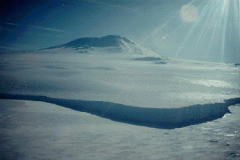November 11, 2009 weblog
Antarctic lake home to diverse community of viruses

(PhysOrg.com) -- A study of the genetic structure of viruses in an Antarctic lake has revealed an astonishing genetic richness in the large number of viral families discovered.
Aquatic viruses usually infect prokaryotes such as bacteria, but the viruses in the Antarctic had a large proportion of viruses that infect eukaryotes. The findings included small single stranded DNA (ssDNA) viruses and phycodnaviruses that have never previously been seen in aquatic environments.
The researchers, Alberto Lopez-Bueno and colleagues, from Spain and the UK, examined samples taken from Lake Limnopolar on Livingston Island in the Antarctic before and during the summer, and found the aquatic environment to be rich in microorganisms and a diverse collection of viruses that prey on them. The number of viral genotypes found was unusually high, running into thousands instead of the more usual hundreds, and less than 3 percent of the genome sequences were similar to previously identified viral genomes from aquatic systems. Many of the ssDNA viruses were related to non-aquatic viruses that infect plants, mammals and birds, and some had never been found in aquatic environments before.
The scientists also observed a change in the virus assemblage with the seasons. When the lake was covered in ice during spring, the smaller single strand DNA viruses dominated, while in summer, when the lake was open, the larger (>50 nanometer) double-stranded DNA viruses dominated, possibly because of seasonal differences in the host organisms, such as the algal blooms that appear in summer.
The scientists also found the double-stranded DNA viruses helped the bacteria survive by assisting their metabolism of amino acids and carbohydrates, and helping with respiration.
Antarctic lakes are covered with ice for around nine months of the year, and the underwater environment is cold, dark, and contains few nutrients, and is home to bacteria, protozoa, algae and viruses, and little else. In these conditions viruses probably play an important part in controlling the other microbes.
Viruses from Antarctica have been difficult to study in the past because they cannot be grown in the laboratory, but new genome sequencing technologies are allowing researchers to identify viruses without the need to grow them.
The research paper is published in the November issue of Science.
More information: High Diversity of the Viral Community from an Antarctic Lake, Science 6 November 2009: Vol. 326. no. 5954, pp. 858 - 861; DOI: 10.1126/science.1179287
© 2009 PhysOrg.com














